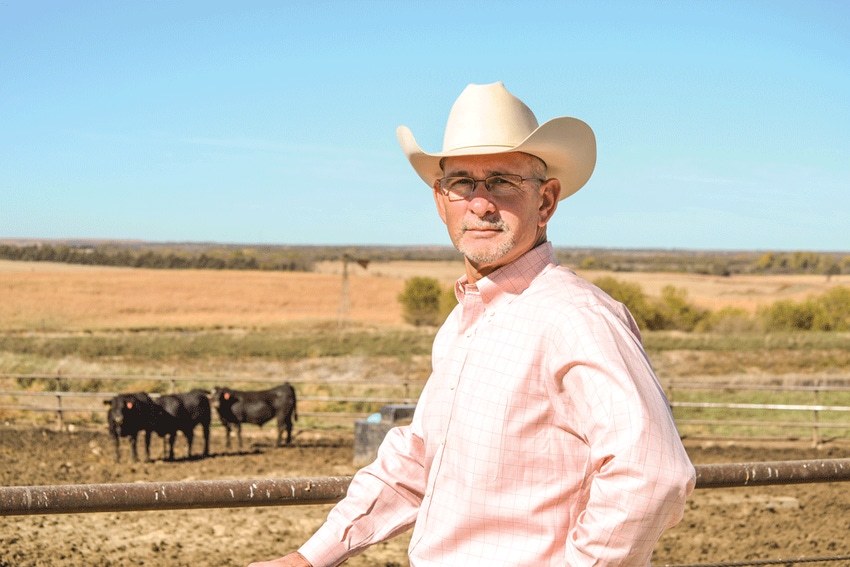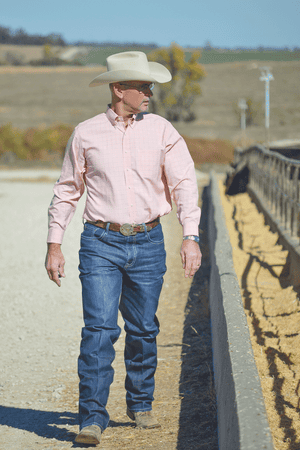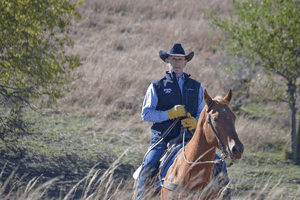Incoming NCBA president, Tracy Brunner, has big-picture view of industry
Tracy Brunner is part of the fourth generation to manage his family’s diversified farming, ranching and cattle feeding operation in the Flint Hills of western Kansas. The incoming NCBA president has a big-picture view of the beef business.

The incoming NCBA president has a big-picture view of the beef business. By Burt Rutherford
It’s likely, when Tracy Brunner graduated from Kansas State University almost 40 years ago, his sights weren’t set on leading the nation’s most influential cattle industry association. It’s likely the newly minted stockman was looking forward to returning to his family’s farming and cattle operation as part of the fourth generation to manage the business.
But life has a way of taking you in directions you don’t always anticipate. For Brunner, the path to the presidency of the National Cattlemen’s Beef Association (NCBA) began shortly after he walked off the graduation stage with diploma firmly in hand.

Industry involvement has always been important to Tracy Brunner. His path to the presidency of NCBA began shortly after college graduation. Photo credit NCBA
Brunner has always respected the way that industry organizations make the beef business better, and he joined the Kansas Livestock Association shortly after graduating. “I really appreciated the way KLA always supplied information and educational opportunities to stay abreast of new technologies that we see emerging, to help cattlemen stay competitive and increase our efficiency, as well as keep us up to date on the issues in the political arena,” Brunner says.
Both those activities — education and political involvement — will be even more important in the years ahead, he believes. Change, challenge and opportunity are all coming at the industry with never-before-seen velocity, and the role of state cattlemen’s associations and NCBA in both protecting and advancing the cattle business will become ever more important.
Path to the presidency
While Brunner has been a member of industry organizations for nearly all his adult life, he first got active in association leadership in the ’90s, when he chaired what was then the KLA Cow-Calf and Stocker Council. He was the KLA representative on the Young Cattlemen’s Conference (YCC) trip in 1996, an experience that further opened his eyes and mind to the larger world around him.
Last year, the 19th anniversary of his first trip, he went on the 2015 YCC trip as a NCBA officer. “There isn’t anything better than rubbing elbows with the next generation of cattlemen. I find I learn from them constantly on how to keep an open mind, embrace new ideas and new ways of doing things. That’s going to be important.”
He rose through the ranks at KLA, serving as the group’s president in 2008. Brunner joined NCBA, then the National Cattlemen’s Association, more than 30 years ago; and as his leadership abilities grew and matured with KLA, his national involvement grew as well. That launched him on his path to the presidency.
“I served two terms on the Cattlemen’s Beef Board, serving on checkoff committees like the former New Products and Culinary Initiatives Committee, where we were involved with the work on muscle profiling that helped us find some undiscovered value in the carcass. I also spent three years as a Cattlemen’s Beef Board representative on the Operating Committee, where we oversaw checkoff expenditures in beef promotion and research programs,” he says.

BEEF Seedstock 100 List
Looking for a new seedstock provider? Use our UPDATED Seedstock 100 listing to find the largest bull sellers in the U.S. Browse the list here.
In addition, through his involvement with KLA, he served on many committees within the policy structure of NCBA, as well as serving on the NCBA board of directors. Then, in 2009 and 2010, he served as vice chair and chair of the NCBA Policy Division, launching him on his trajectory to becoming NCBA president in 2016.
That deep and long involvement on both sides of the beef business — policy and promotion — have given Brunner an exceedingly well-rounded education in how the beef business functions at the organizational level. That breadth and depth of understanding will serve him, and all cattle producers, well as he goes through his year as NCBA president.
“The role of leadership in NCBA is to advance the policies that the membership determines. Beyond that, my goal would be to help take NCBA to a higher level of effectiveness. Over the past several years, our membership has told us that they are ready and willing to invest at a greater level. And for that, we will expect a higher degree of success and achievement.”
Long industry background
Brunner is the fourth generation to help manage his family’s diversified operation, and the fifth has boots on the ground beginning to learn the ropes. “We are a family farming and ranching operation in the western Flint Hills of Kansas,” Brunner says. “We grow crops and cattle and have been here for over 100 years.”
The operation is highly diversified, with a seedstock enterprise; a yearling grazing operation in the Flint Hills; and Cow Camp Feed Yard at Ramona, Kan., an 8,000-head custom feedyard. The feedyard is supported by a 4,000-acre farming operation. “Which is a nice ecosystem, if you will,” he says. “We’re able to recycle a lot of the nutrients that come from the fields through the cattle, and then back on the fields.”

70+ photos showcasing all types of cattle nutrition
Readers share their favorite photos of cattle grazing or steers bellied up to the feedbunk. See reader favorite nutrition photos here.
The operation not only feeds its own cattle but also works with the customers of its seedstock business. “We try to get those calves into the feedyard, where we can feed some high-quality cattle of known genetics and also evaluate the genetics of our seedstock business,” he says. When ready for harvest, most of the fed cattle are marketed through U.S. Premium Beef.
What’s ahead?
Brunner looks back on his more than four decades of industry involvement fondly. “I have really benefited not only from the opportunity to share some views in those organizations — but more importantly, what I’ve been able to learn by associating with other producers and other related industries that use our organizations as a forum, for not only surfacing ideas about how to better the opportunities within the industry, but also ways to share new technologies,” he says. “The education aspect of our state and national organizations has always been very key in the continuing education for me over the years.”
That education — learning how to be better at things you already do well — is an important and vital aspect of NCBA’s many programs. But Brunner is a realist, and he knows NCBA’s value to cattlemen extends well beyond that, into the rough-and-tumble world of ensuring that cattle producers have the freedom to operate.
“We’ve got to stay active in our government,” he says. “Government overreach has got to be countered and pushed back at every opportunity. We need the freedom to operate; we need the ability to make individual investments on our farms and ranches that are best for our individual operations.”
Beyond that, he looks to the Industry Long Range Plan and its challenge to increase beef demand 2% a year to maintain today’s price environment. “One way we will increase demand is through expanded trade,” he believes.
“The vast majority, 95%, of our potential future market lies outside our borders. There’s a growing world population that wants our high-quality beef, and is going to be more willing and able to pay the cost of that beef as time goes on. So we need freer and more open markets to let us access that growing global demand for beef.”
That may bring some management opportunities, he adds. “Our nation’s beef supply is increasingly important in the food security of our country and the rest of the world,” he says. And that means there will likely be increased pressure on the U.S. to develop a more robust traceability system.
“An infectious animal disease could wreak havoc on our current marketing and distributing systems, and cause severe economic harm to everyone in the beef chain, from producers to consumers. A simple baseline traceability system that will allow containment and eradication of a disease while maintaining consumer confidence in our industry and its product is both needed and necessary,” he says.
 Brunner believes the beef business — collectively as well as each individual — has an important role in building consumer confidence now, while times are good. “Cattlemen need to accept the responsibility to tell their story. No one understands what we do better than cattlemen, and we have to accept that role, step up and share all the good things that go unnoticed about our contributions socially, environmentally and economically,” he says.
Brunner believes the beef business — collectively as well as each individual — has an important role in building consumer confidence now, while times are good. “Cattlemen need to accept the responsibility to tell their story. No one understands what we do better than cattlemen, and we have to accept that role, step up and share all the good things that go unnoticed about our contributions socially, environmentally and economically,” he says.
That’s an important aspect of the sustainability discussion, something he believes the cattle business must embrace. “One of the most important long-term areas, I believe, is our acknowledgement of our responsibility to work in the area of image and acceptance, that area of sustainability.”
Tracy Brunner is a humble man who much prefers to talk about the business he loves and the people he respects who make the business so great, than to talk about himself. Perhaps that’s why he’s driven to give so much of himself.
“I think we’re all interested in being part of something that’s bigger than us,” he says. “I think we each have an inherent desire to leave our surroundings a little bit better than we found them. I often find myself thinking about the next generation, not only of our family but of the beef community. I do not want to miss an opportunity that might happen to help improve things for the next generations.”
You might also like:
7 ranching operations who lead in stewardship, sustainability
Why we need to let Mother Nature select replacement heifers
Photo Gallery: Laugh with Rubes cow cartoons
Beta agonists wrongly blamed for fatigued cattle syndrome
About the Author(s)
You May Also Like



